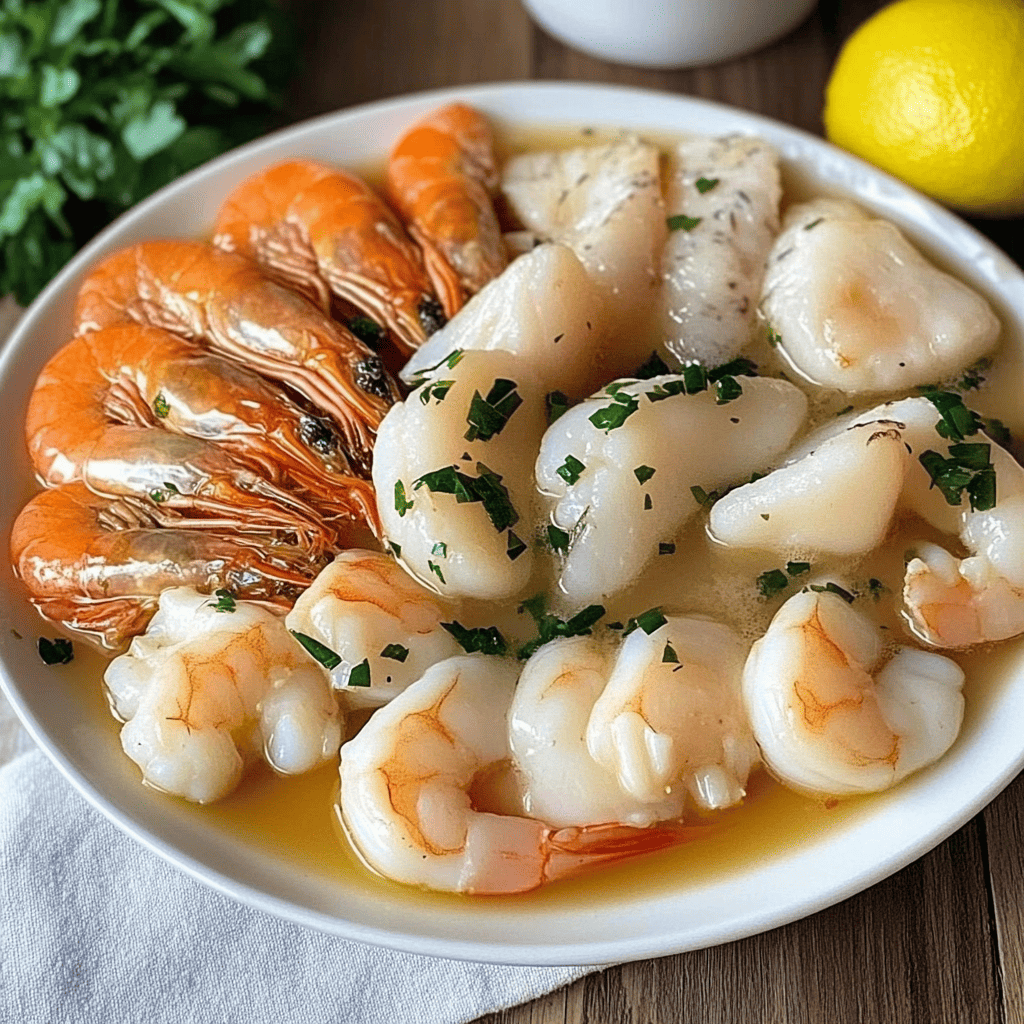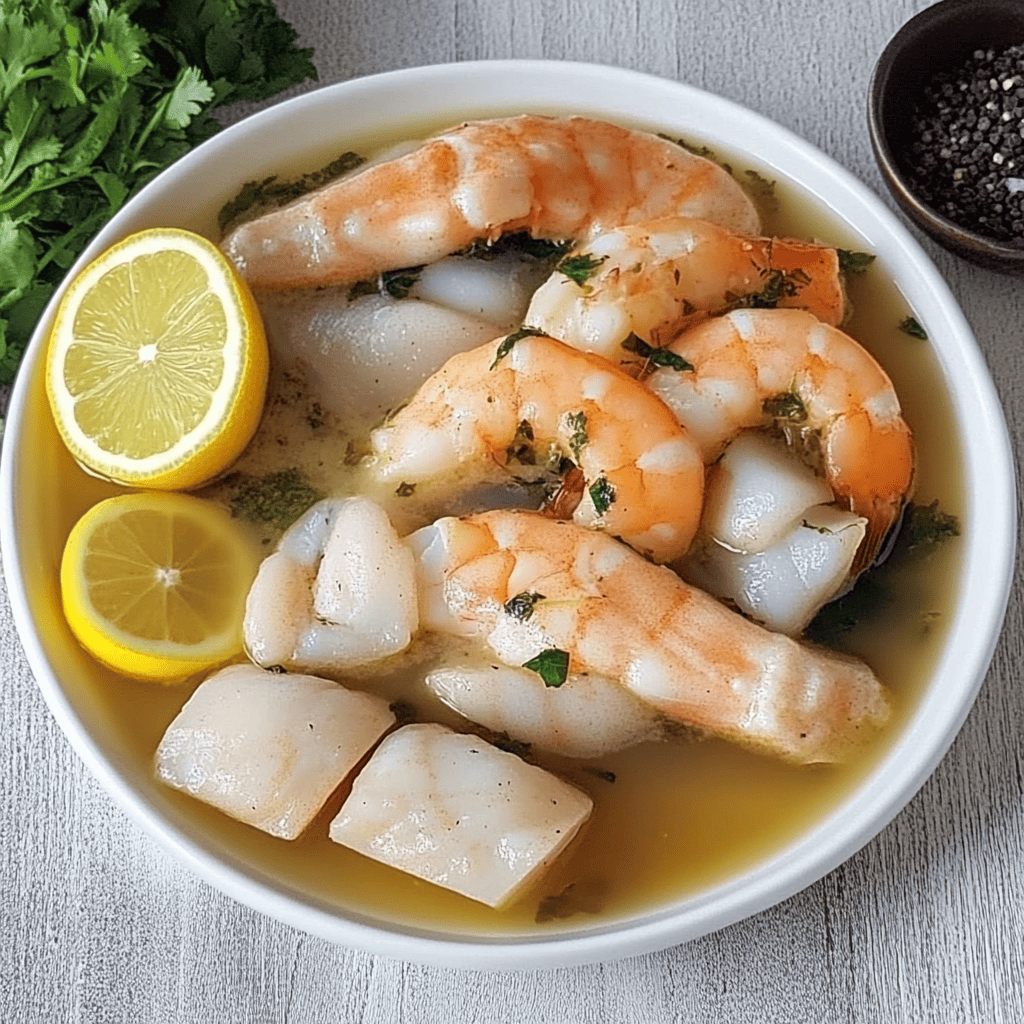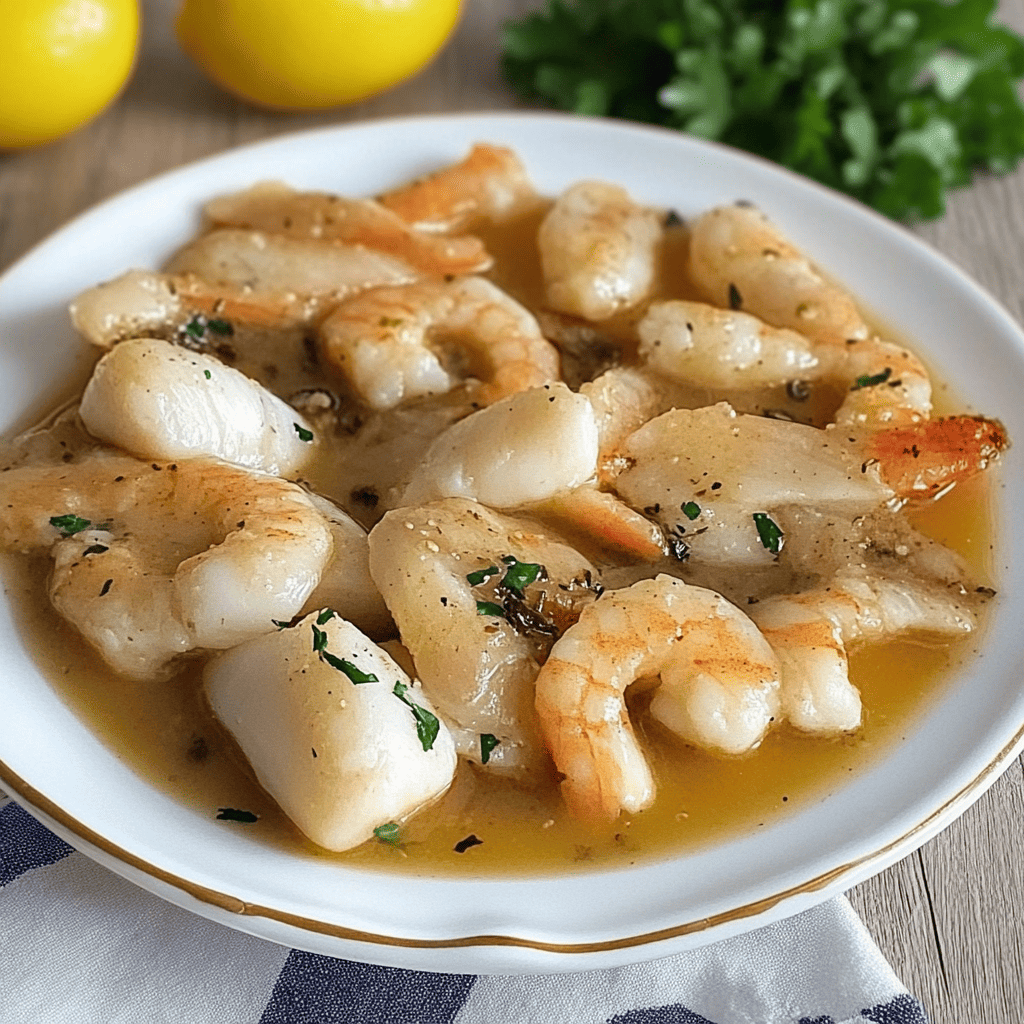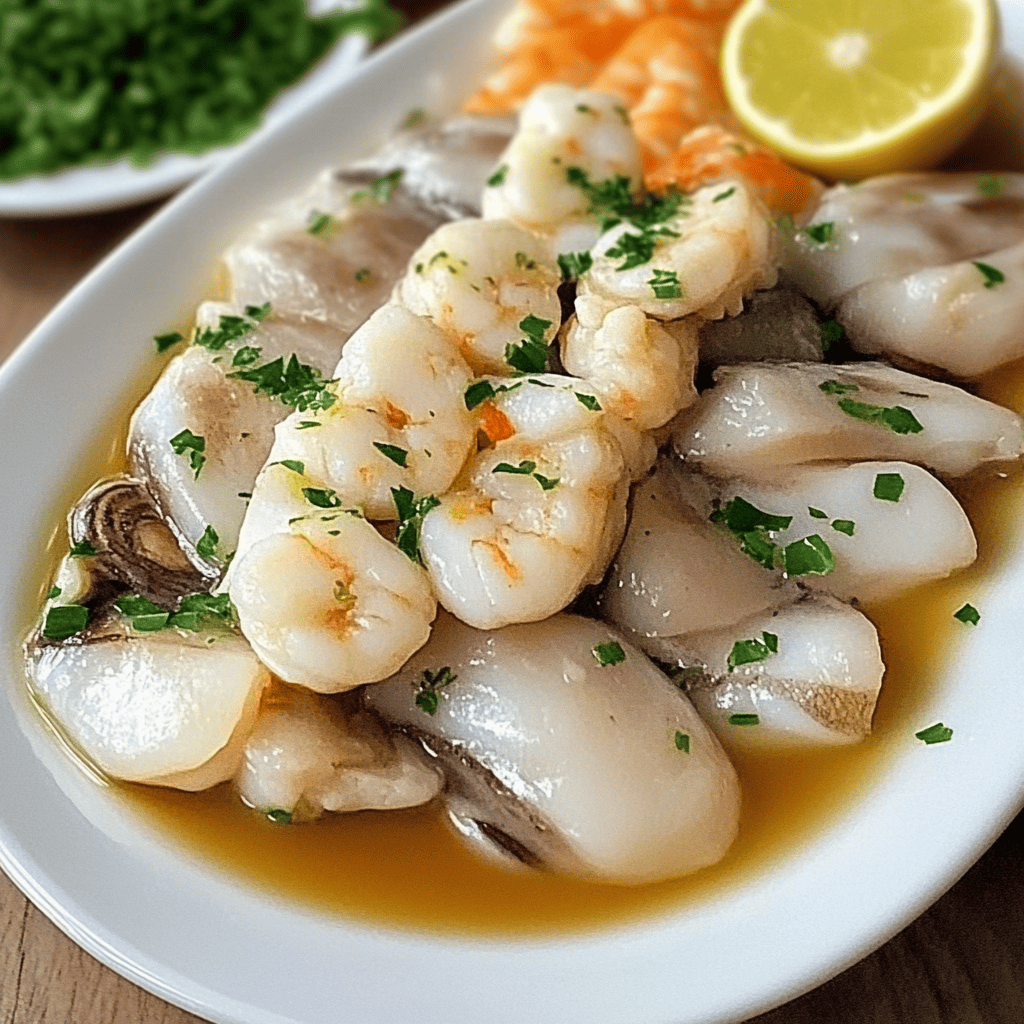Hake a la Marinera: The Essence of the Sea in a Dish
Introduction
Merluza a la Marinera is an iconic dish of Spanish cuisine, a true classic that honors the richness of seafood. Simple in its conception but sublime in its result, it combines the delicate flesh of the hake with a light yet flavorful sauce made with garlic, parsley, white wine, and the juice released by the clams. It is often enriched with the addition of shrimp, giving it an extra touch of sophistication and flavor. This seafood stew is a perfect example of how fresh, quality ingredients, treated with respect, can be transformed into an unforgettable culinary experience. It is an elegant, nutritious dish, perfect for any occasion, from a family meal to a special celebration.
Detailed History
The history of Merluza a la Marinera is intertwined with the fishing and culinary traditions of the Spanish coast, especially in northern regions such as Galicia and the Basque Country, where fresh fish is a fundamental pillar of the diet.
Hake, Queen of the Waters: Hake (Merluccius merluccius) is one of the most prized white fish in Spain. Its fine, white flesh and mild flavor have made it a versatile ingredient in the kitchen, suitable for a wide variety of preparations: boiled, baked, fried, or, as in this case, in sauce. Fishing for hake has been a crucial economic and food source for many Spanish coastal communities for centuries.
The Origin of Sauce Marinara: The concept of “sauce marinara” or “sauce a la marinera” is ancestral in Mediterranean cuisine. It refers to a preparation that uses the cooking juices of fish or shellfish, along with basic coastal ingredients such as garlic, parsley, and white wine, to create a light sauce that enhances the flavor of the main product without masking it. It is not a thick, heavy sauce, but rather a reduced, aromatic broth that infuses the fish. Clams, which open, releasing their delicious juices, are a fundamental ingredient in this sauce, providing a salty and sweet umami.
Fish Cuisine in Spain: In Spain, fish cuisine has a deep-rooted tradition. Each coastal region has its own specialties and techniques for cooking fresh fish. Simplicity is often key, allowing the quality of the product to shine. “Merluza a la gallega” (with boiled potatoes and a garlic and paprika stir-fry) or “merluza a la koskera” (a Basque version with peas, asparagus, and clams) are examples of the mastery in the treatment of this fish. “Merluza a la marinera” (merluza a la marinera) is part of this tradition of dishes that celebrate the freshness of the sea with minimal handling.
Using Clams and Shrimp: Incorporating clams and shrimp into fish stews is a common practice to enhance the flavor and texture. When clams open, they release a saline nectar that is a natural flavor enhancer for the sauce. Shrimp, with their sweetness and firmer texture, complement the delicacy of hake.
Although there is no exact date for the birth of Merluza a la Marinera, it is the result of centuries of evolution in seafood cuisine, where the freshness of the sea and the simplicity of preparation came together to create a timeless and delicious dish.
More Historical Detail
The simplicity of Merluza a la Marinera contrasts with the sophistication of some haute cuisine sauces. Its beauty lies in the use of everyday yet fresh ingredients and a technique that seeks to extract maximum flavor from them. “Refrito” or “ajillo,” which consists of browning garlic in olive oil and then adding parsley, is a fundamental technique in Spanish cuisine, especially for fish dishes. It is the starting point for countless stews and dressings, providing an unmistakable aromatic base.
White wine, often a local wine from the region, is used not only for its flavor but also for its acidity, which helps lift the flavors and deglaze the bottom of the casserole, incorporating all the “sucos” or cooking juices. The lightness of the sauce makes it suitable for different diets and occasions, and its versatility to add other seafood or vegetables (such as peas or asparagus, which are sometimes found in more elaborate versions) makes it adaptable to personal tastes and ingredient availability.
This dish is a reflection of a cuisine that values the product above all else, where fresh hake is the star and the sauce is an accompaniment that enhances it, not overpowers it.

Ingredients
To create this culinary gem of the sea, you will need:
4 fresh hake loins (or slices), about 180-200 g each
500 g of fresh (or frozen) clams
200g peeled shrimp (fresh or frozen, raw)
3-4 cloves of garlic, finely sliced
A good bunch of fresh parsley, chopped
1/2 cup fish stock (or water)
4-5 tablespoons of extra virgin olive oil
Salt to taste
Freshly ground black pepper to taste
Lemon slices (for serving, optional)
Detailed Preparation
Follow these steps carefully to achieve tender hake and a flavorful sauce:
Step 1: Preliminary Preparation of the Seafood
- Clams: If using fresh clams, purging them to remove the sand is crucial. Place them in a large bowl with cold water and a generous tablespoon of salt for at least 30 minutes to 1 hour (or ideally 2-3 hours). Change the water several times if you see a lot of sand. Discard any open clams that don’t close when gently tapped, or any broken clams. Once purged, drain and rinse them well.
- Shrimp: If using frozen shrimp, thaw them according to the package instructions. If using fresh shrimp, peel them (you can reserve the heads and shells for quick broth if desired).
Step 2: Preparing the Hake
- Season the hake loins or slices with salt and freshly ground black pepper on both sides.
- If the fish is very wet, pat it dry with kitchen paper.
Step 3: The Flavored Sofrito
- In a wide, shallow saucepan (ideally a deep skillet or a stovetop clay pot), heat the extra virgin olive oil over medium-low heat.
- Add the sliced garlic. Cook over very low heat so the garlic browns slightly and flavors the oil without burning. This is crucial for a mild, non-bitter flavor.
- When the garlic is golden, add half of the chopped fresh parsley. Cook for about 30 seconds, just until the parsley releases its aroma. Be careful not to burn it.
Step 4: Cooking the Hake and Deglazing
- Increase the heat to medium. Place the hake fillets or slices in the pan. Brown them lightly on one side for 2-3 minutes. It’s not necessary to cook them completely at this point.
Step 5: Add Seafood and Finish the Sauce
- Pour the fish stock (or water) into the saucepan.
- Distribute the purged clams around the hake.
- Cover the pan and cook over medium-low heat for 3-5 minutes, or until all the clams have opened. Discard any clams that don’t open.
- Once the clams are open, add the peeled shrimp to the pan. Cook for just 1-2 more minutes, stirring gently, until the shrimp change color and turn pink. Don’t overcook them, as they will toughen.
Step 6: Final Touch and Served
- Remove the saucepan from the heat.
- Sprinkle generously with the remaining chopped fresh parsley.
- Serve the hake and shellfish directly from the casserole, with plenty of sauce.
- Optionally, you can serve it with a few lemon slices for each diner to squeeze to their liking.
Estimated Preparation Time
- Active prep time: 20-25 minutes (including clam cleaning and fish/seafood preparation)
- Clam soaking time (purge): 30 minutes to 2-3 hours (not active cooking time)
- Cooking time: 10-15 minutes
- Total estimated time (without purging): Approximately 30-40 minutes
Additional Tips
- Freshness of Fish and Seafood: The key to this dish is the freshness of the hake, clams, and shrimp. Buy from a trusted fishmonger.
- Purging Clams: Don’t skip the step of purging the clams. Sand would ruin the dish. If you don’t have time, you can buy pre-purged clams or good-quality frozen ones.
- Don’t Overcook: Hake and shrimp cook very quickly. Overcooking them will make them dry and rubbery. Cook until just cooked through.
- Fish Stock: A good homemade fish stock will significantly enhance the flavor of the sauce. If you don’t have any, you can use good-quality packaged fish stock or even water, but the flavor will be less profound.
- Garlic and Parsley Sauté: Cook the garlic over very low heat to release its full aroma without burning. Add the parsley at the end or near the end to retain its freshness and color.
- White Wine: Use a wine you enjoy drinking. Its flavor will be concentrated in the sauce.
- Variants:
- You can add a tablespoon of flour to the garlic and parsley sauce before adding the wine to slightly thicken the sauce.
- Some versions include a few peas or saffron threads at the end of cooking for color and flavor.
- You can add a splash of cognac or brandy at the beginning, flambéing it, for extra depth of flavor.
- Serve Immediately: This dish is best enjoyed freshly made, when the hake is tender and the sauce is hot.

Questions and Answers
Can I use frozen hake? Yes, you can use frozen hake loins or slices. Make sure to thaw it completely in the refrigerator and dry it thoroughly with a paper towel before seasoning and cooking.
What should I do if some clams don’t open? Discard any clams that don’t open after cooking. This indicates they weren’t alive or weren’t in good condition.
Can the sauce be prepared in advance? You can prepare the sofrito base (garlic, parsley, wine, broth) in advance. However, fish and shellfish should be cooked just before serving to ensure optimal texture and flavor.
What can I use instead of clams if I can’t find them? You can omit the clams and use only shrimp, or even add mussels (previously steamed and their juices added to the sauce). The flavor will be different, but it will still be delicious.
Is this recipe gluten-free? Yes, it’s naturally gluten-free if you don’t add flour to thicken the sauce. Make sure your white wine is gluten-free (most aren’t) and that any packaged fish stock is also gluten-free.
Texture and Flavor
Hake a la Marinera is a delight of textures and flavors that complement each other perfectly:
- Texture: The hake is the heart of the dish, with tender, flaky white flesh that melts easily in the mouth. The shrimp are juicy and slightly firm , with a soft “snap.” The clams are soft and delicate , with a slightly elastic texture. The sauce , meanwhile, is light and fluid , yet full-bodied, without being thick, allowing it to coat the fish and shellfish without overpowering them.
- Taste: The flavor is fresh, salty, and aromatic , with a distinct Mediterranean profile. The mild, sweet taste of the hake is enhanced by the seaside flavor of the clams and shrimp . The garlic adds a warm, penetrating note, while the parsley infuses a vibrant, herbaceous freshness. The white wine adds subtle acidity that balances the salinity and flavors of the sea, and its aromatic notes are concentrated in the sauce. The overall flavor is clean, authentic, and deeply comforting, transporting you directly to the coast.
Consumer Context
Hake a la Marinera is an elegant and versatile dish, ideal for various occasions:
- Main Course: It is an excellent main course for a special lunch or dinner, due to its presentation and delicate flavor.
- Celebrations: Perfect for holidays like Christmas, Easter, or birthdays, as it’s a crowd-pleasing dish and relatively easy to prepare in large quantities.
- Family Meal: Although sophisticated, this dish is also very enjoyable at family gatherings, offering a healthy and delicious option.
- Romantic Dinner: Due to its elegance and lightness, it is an excellent option for an intimate dinner.
- Pairing: It pairs exceptionally well with dry, crisp white wines, especially from the dish’s region of origin (Galicia or the Basque Country), such as Albariño, Txakoli, or Ribeiro. It also pairs well with Cava or a dry sparkling wine.
Visual Aspect
Hake a la Marinera is a visually appealing dish, with a harmonious composition of colors and textures:
- Marine Colors: The pure white of the cooked hake contrasts with the bright pink of the peeled shrimp and the paler shade of the open clams, creating a palette of sea colors.
- Golden Sauce: The sauce, with its pale gold to light amber color, is glossy and translucent, reflecting its lightness and its content of olive oil and cooking juices.
- Vibrant Green Touch: Freshly chopped parsley sprinkled generously over the dish is the finishing touch that adds a vibrant green color, enhancing the freshness and overall aesthetic.
- Platter Presentation: It is generally presented on a wide, oval platter, which allows you to appreciate the arrangement of the hake, seafood and sauce.
- Invitation to Taste: The overall appearance of the dish is fresh, clean, and appetizing, inviting you to dip your fork into the delicate hake meat and soak it in the tasty sauce.
Curiosities
- White Fish par Excellence: Hake is the most consumed white fish in Spain, appreciated for its versatility and low fat content.
- Clams and the Heart: Clams are a source of iron and vitamin B12, and are considered beneficial for cardiovascular health.
- Fresh Parsley: Beyond garnish, parsley is essential in this dish. Its herbaceous and slightly bitter flavor balances the richness of the seafood.
- The Mediterranean Diet: This dish is a perfect example of the Mediterranean diet, which emphasizes fish, olive oil, garlic, and fresh herbs.
- Leftover Cooking: Traditionally, “sailor sauce” was made from leftover fish or shellfish, creating broths that left nothing behind and concentrated the flavor.
Nutritional Value (estimated per serving)
The exact nutritional value of Hake in Marinera sauce may vary depending on the amount of oil, the portion size, and whether it’s served with or without a side dish. Below is a rough estimate for 4 servings (without side dishes such as rice or potatoes):
Estimated serving (1/4 of the recipe, without accompaniment):
- Calories: 280-350 kcal
- Total Fat: 12-18 g
- Saturated Fat: 2-4 g
- Cholesterol: 150-250 mg
- Sodium: 500-800 mg (naturally from shellfish and added salt)
- Total Carbohydrates: 5-8 g (from vegetables and wine)
- Sugars: 1-3 g
- Fiber: 1-2 g
- Protein: 35-45 g
Considerations:
- High Quality Protein: Excellent source of complete proteins.
- Healthy Fats: Extra virgin olive oil provides beneficial monounsaturated fats.
- Vitamins and Minerals: Rich in iodine, selenium, phosphorus, vitamin B12, and B vitamins.
- Low Carb: A naturally low-carb dish, making it suitable for ketogenic or low-carb diets if served alone.
This dish is a very healthy and nutritious option, especially due to its high protein and healthy fat content.
Additional Benefits and Interesting Facts
- Cardiovascular Health: The omega-3 fatty acids found in fish (although hake is a white fish, it still provides some) and the healthy fats in olive oil contribute to heart health.
- Rich in Iodine: Seafood is an excellent source of iodine, vital for thyroid function.
- Anti-inflammatory Properties: Garlic and parsley are known for their anti-inflammatory and antioxidant properties.
- Dietary Versatility: Being a dish based on lean proteins and healthy fats, it is suitable for a wide range of diets, including low-carb and Mediterranean diets.
- Easy to Digest: White fish is generally easy to digest, making this dish a great choice for people with sensitive stomachs.
Other Information
- Preparing Frozen Clams: If you’re using frozen clams, you don’t need to purge them, but you do need to thaw them before adding them to the casserole. Some clams come precooked, in which case they only need a quick reheat.
- Fish Variations: Although hake is the star, this same sauce works wonderfully with other firm white fish, such as monkfish, fresh cod, or even turbot.
- Presentation: For a more rustic presentation, you can serve the dish directly in the casserole dish on the table.
- Bread Pairing: Don’t forget a good rustic bread or baguette to dip in the delicious sauce; it’s one of the best parts of the dish!

Conclusion
Merluza a la Marinera is a treasure of Spanish gastronomy, a dish that celebrates the simplicity and freshness of seafood. Its delicate hake, juicy shrimp, and the salty touch of the clams merge in an aromatic sauce of garlic, parsley, and white wine, creating an unforgettable culinary experience. Beyond its exquisite flavor, this dish embodies the tradition of Mediterranean cuisine, offering a nutritious, elegant, and adaptable option for any occasion. Preparing Merluza a la Marinera isn’t just about cooking; it’s an act of respect for the product and an invitation to enjoy the authentic and pure flavors of the sea. Dare to immerse yourself in this tradition and delight in every bite!

